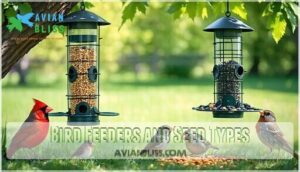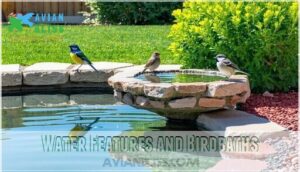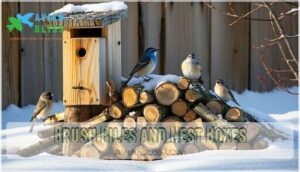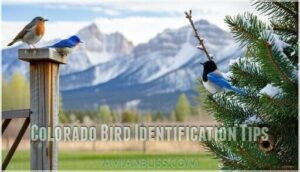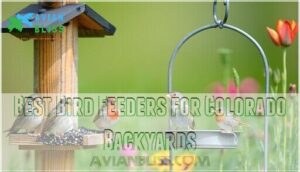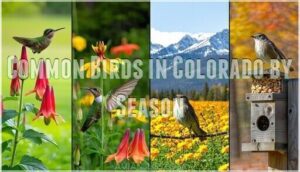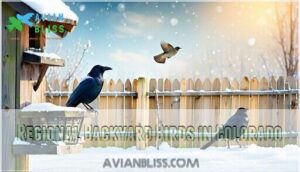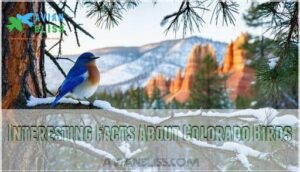This site is supported by our readers. We may earn a commission, at no cost to you, if you purchase through links.
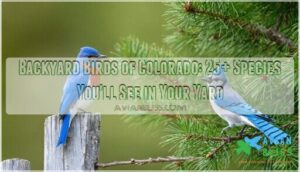
Common year-round residents include Black-capped Chickadees, House Finches, and White-breasted Nuthatches that’ll become your feeder regulars.
During spring and summer, Western Tanagers and Broad-tailed Hummingbirds add splashes of color to your yard.
Your elevation matters – Denver suburbs host different species than mountain properties, and this affects the types of birds you’ll see, including Cardinals, Blue Jays, and Red-winged Blackbirds that frequent many Colorado yards.
Steller’s Jays prefer higher elevations, while the secret to attracting this diverse mix lies in understanding what each species needs for food, water, and shelter.
Table Of Contents
- Key Takeaways
- Colorado Backyard Birds Overview
- Most Common Backyard Birds in Colorado
- Attracting Birds to Your Yard in Colorado
- Colorado Bird Identification Tips
- Best Bird Feeders for Colorado Backyards
- Common Birds in Colorado by Season
- Regional Backyard Birds in Colorado
- Birding Locations and Hotspots in Colorado
- Interesting Facts About Colorado Birds
- Frequently Asked Questions (FAQs)
- How can I identify a bird in my yard?
- What is the most common bird in Colorado?
- When to put out bird feeders in Colorado?
- What’s the most common backyard bird?
- What are the most common backyard birds in Colorado?
- What does a Bluebird look like in Colorado?
- What does a rotund bird look like in Colorado?
- Where to find mountain bluebirds in Colorado?
- How do I identify a bird in my backyard?
- What birds can I attract to my yard?
- Conclusion
Key Takeaways
- You’ll find over 25 bird species in your Colorado backyard year-round, with American Robins being the most common at 38% frequency, followed by House Finches, Northern Flickers, and Dark-eyed Juncos.
- Your elevation and location determine which species you’ll attract – Denver suburbs host different birds than mountain properties, with Steller’s Jays preferring higher elevations while American Crows dominate urban areas.
- You can attract the widest variety of birds by offering black oil sunflower seeds in tube feeders, maintaining shallow water sources under two inches deep, and planting native species like serviceberry and chokecherry.
- Colorado’s bird populations change dramatically by season – you’ll see year-round residents like chickadees and nuthatches, spring arrivals like Broad-tailed Hummingbirds, and winter visitors like Mountain Chickadees at your feeders.
Colorado Backyard Birds Overview
Colorado’s backyard bird community includes over 25 species that you’ll regularly spot throughout the year, from year-round residents like American Robins and House Finches to seasonal migrants such as Broad-tailed Hummingbirds.
You can expect to see different species based on your location within the state, with mountain regions hosting Black-billed Magpies while urban areas attract American Crows and European Starlings.
Year-Round Residents
Why do some Colorado birds stick around all year?
Year-round residents have mastered winter survival through remarkable resident adaptations. These hardy bird species maintain stable population trends by adjusting their breeding habits and habitat preferences to Colorado’s changing seasons.
Colorado’s year-round birds are true survivors, mastering winter’s challenges through incredible adaptations and flexible habits.
Here are three key characteristics of Colorado’s year-round backyard birds:
- Cold-weather tolerance – Species like Black-capped Chickadees grow extra feathers for insulation
- Flexible diets – House Finches switch from insects to seeds when temperatures drop
- Shelter-seeking behavior – Northern Flickers roost in tree cavities during harsh weather
Seasonal Migrants
Beyond your year-round neighbors, migratory birds transform Colorado backyards seasonally.
These travelers follow ancient migration routes, using your yard as stopover habitats during spring and fall journeys.
Migration triggers like daylight changes and temperature shifts guide their movement between breeding grounds and wintering areas.
Colorado birds face conservation challenges during these epic travels.
Birds often use geomagnetic navigation cues to orient themselves during these long flights.
You’ll notice Colorado backyard birds like Broad-tailed Hummingbirds arriving in May and departing by September, creating dynamic seasonal bird migration patterns.
Common Bird Species in Colorado
Backyard enthusiasts will discover remarkable diversity among Colorado bird species.
Robin dominance stands out with their 38% frequency, while Finch frequency reaches impressive numbers at feeders year-round. These common birds showcase Colorado’s rich avian community through varied behaviors and adaptations.
- American Robins rule Colorado backyards with consistent year-round presence and distinctive orange breasts
- House Finches display remarkable Finch frequency, visiting 84% of backyard feeders with average groups of seven
- Northern Flickers adapt to diverse Flicker habitats from woodlands to suburban yards across Colorado
- Black-billed Magpies flash stunning Magpie plumage with iridescent blue-green tail feathers catching sunlight
- Dark-eyed Juncos show fascinating Junco variations with gray-black bodies and distinctive white bellies
Most Common Backyard Birds in Colorado
Robin Dominance defines Colorado’s backyard bird scene, with these orange-breasted favorites appearing on nearly 40% of all bird-watching checklists. You’ll spot them hopping across lawns year-round, making them perfect for bird identification practice.
Finch Popularity runs strong throughout the state, as House Finches visit 84% of Colorado feeders with their cheerful red faces and social nature. These common birds travel in groups of seven, creating lively scenes at your bird feeders.
The Northern Flicker’s distinctive brown-and-black barred pattern shows Flicker Frequency across 35% of Colorado yards. You’ll recognize their undulating flight and hear their loud "wick-wick-wick" calls.
Magpie Presence brings drama to backyard birds watching, with their striking black-and-white plumage and iridescent tail feathers. Dark-eyed Juncos showcase Junco Variations from slate-gray to brown, especially during winter months.
Black-capped Chickadees round out Colorado’s top five, visiting 70% of yards with their acrobatic feeding style.
Attracting Birds to Your Yard in Colorado
You can transform your Colorado backyard into a bird haven by providing the four essentials that attract over 500 species found throughout the state: food sources, fresh water, shelter, and nesting sites.
Strategic placement of native seed feeders, shallow water features, and brush piles will draw common residents like American Robins, House Finches, and Dark-eyed Juncos to your yard year-round, utilizing the provided shelter.
Bird Feeders and Seed Types
Right feeders and quality birdseed make all the difference in attracting Colorado’s backyard birds. Black oil sunflower seeds draw the widest variety, while nyjer seeds target finches specifically.
Strategic feeder placement and regular cleaning keep birds healthy and coming back. Safflower seeds, on the other hand, are a cardinal and sparrow magnet.
- Seed Blends: Choose high-quality mixes avoiding cheap fillers like milo
- Feeder Placement: Position 10+ feet from trees for safety
- Squirrel Deterrents: Use baffles to protect bird food
- Cleaning Feeders: Sanitize monthly preventing disease spread
Water Features and Birdbaths
Water sources attract more backyard birds to your Colorado yard than feeders alone.
Place bird baths near shrubs for quick escape routes, ensuring bird safety from predators.
Choose shallow designs under two inches deep. Cleaning frequency should be every few days to prevent algae and disease.
Many options are available if you need a bird bath.
Consider winterizing baths with heaters during Colorado’s harsh winters for year-round bird attraction.
Native Plants and Gardening
Beyond providing fresh water, creating bird-friendly gardens with native plant selection transforms your Colorado backyard into prime bird habitat.
Native plants support up to 261 insect species that backyard birds depend on for food. Xeriscaping benefits include reduced maintenance while supporting local wildlife through habitat restoration.
To help prevent the spread of disease, remember to clean bird baths weekly.
Consider these seasonal gardening essentials for bird feeding success:
- Serviceberry provides berries and shelter for multiple species
- Chokecherry supports diverse bird populations year-round
- Gambel Oak offers extensive insect populations for bird feeding
- Native sunflowers produce seeds that attract finches and sparrows
Brush Piles and Nest Boxes
Your backyard’s brush piles create essential winter shelters for Colorado’s backyard birds.
Stack fallen branches loosely, leaving gaps for small birds to escape predators.
Nest boxes need proper placement—face entries away from prevailing winds and mount six feet high.
Choose cedar or pine for durability.
Essential bird products can further enhance the habitat.
Clean boxes annually after nesting season ends to maintain healthy bird habitat.
Colorado Bird Identification Tips
You’ll identify Colorado’s backyard birds more accurately when you focus on size, shape, and bill type before considering colors or patterns.
Start by comparing unknown birds to familiar species like the American Robin or House Finch, then examine their habitat preferences and feeding behaviors to confirm your identification.
Size and Shape
Identifying Colorado backyard birds starts with mastering size and shape recognition. Use relative size comparisons – is it smaller than a robin or larger than a chickadee? Bill shape reveals feeding habits, while tail length provides essential identification clues. Notice body shape differences between stocky finches and slender flycatchers. Wing span variations help distinguish species during flight.
Focus on these key identification markers:
- Body shape – Compare proportions to familiar bird species
- Bill shape – Thick seed-crackers versus thin insect-catchers
- Tail length – Short and stubby or long and pointed
- Wing span – Compact wings versus broad, soaring wings
This bird guide approach works before considering color patterns.
Color Patterns and Plumage
Color patterns serve as your best friend when identifying Colorado backyard birds.
American Robins display rusty orange breasts, while House Finches show red markings on males.
Notice Black-billed Magpies’ iridescent plumage that shifts from black to blue-green.
Seasonal molting creates color variation throughout the year.
Bird markings like the Dark-eyed Junco‘s white belly provide reliable identification cues for distinguishing similar bird species.
Plumage variations may also require careful color observation.
Habitat and Behavior
Each species reveals unique stories through their daily routines.
Nesting habits vary dramatically—robins build cup-shaped nests while flickers excavate tree cavities.
Foraging strategies differ too: chickadees hang upside-down on branches, while juncos scratch ground litter.
Social interactions range from solitary nuthatches to gregarious finch flocks.
Bird songs help identify species, while predator avoidance behaviors like alarm calls protect backyard birds in Colorado’s diverse bird habitats.
Best Bird Feeders for Colorado Backyards
You’ll attract Colorado’s diverse backyard birds more effectively when you choose the right feeder types for their specific feeding preferences.
Different species like House Finches, American Robins, and Northern Flickers require tube feeders, platform feeders, and suet feeders to meet their varied dietary needs throughout the year, and choosing the right types is crucial for attracting them, which involves understanding their dietary needs.
Tube Feeders and Seed Types
Why struggle with choosing the right tube feeder when you can attract Colorado’s backyard birds with strategic seed selection?
Tube feeders work best when positioned away from windows and equipped with squirrel baffles to protect your birdseed investment.
Consider these top seed choices for Colorado bird food preferences:
- Black oil sunflower seeds – Attracts house finches, chickadees, and nuthatches year-round
- Nyjer seed – Perfect for goldfinches and siskins during migration seasons
- Mixed seeds – Provides variety that appeals to diverse backyard bird species.
Proper feeder placement near native plants enhances your bird-watching success.
Platform Feeders and Ground Feeders
Platform feeders welcome ground-feeding Colorado backyard birds like Dark-eyed Juncos and Mourning Doves.
These open-tray designs allow easy access while preventing Seed Spillage that attracts unwanted pests.
Strategic Feeder Placement near shrubs provides Predator Protection, while raised edges contain bird food preferences.
Regular Feeder Hygiene prevents disease spread among visiting species.
| Feature | Benefit | Best For |
|---|---|---|
| Open Design | Easy access | Ground-feeding birds |
| Raised Edges | Contains seeds | Reducing spillage |
| Low Height | Natural feeding | Sparrows, doves |
Suet Feeders and Hummingbird Feeders
Suet feeders attract woodpeckers and nuthatches during Colorado’s harsh winters.
Mix basic suet ingredients like beef fat, peanut butter, and seeds for homemade cakes.
Hummingbird nectar requires a simple 4:1 water-to-sugar ratio—skip red dye entirely.
Strategic feeder placement near shrubs provides cover while maintaining visibility.
Cleaning feeders weekly prevents harmful mold and bacteria.
DIY feeders from recycled materials work perfectly for Colorado bird feeding.
These specialized Colorado bird feeders complement your existing setup, creating diverse feeding stations that attract different backyard birds throughout the seasons.
Common Birds in Colorado by Season
Colorado’s bird populations change dramatically throughout the year, with some species like American Robins and Dark-eyed Juncos staying year-round while others migrate seasonally.
You’ll notice Broad-tailed Hummingbirds and House Wrens arrive for spring and summer, then disappear as winter birds like Mountain Chickadees become more common at your feeders, illustrating the seasonal dynamics of local bird populations.
Winter Bird Species
Colorado’s winter birds showcase remarkable cold adaptations and winter survival strategies.
Dark-eyed Juncos arrive from northern regions, demonstrating unique migration patterns as they seek reliable food sources.
These hardy backyard birds develop specialized roosting habits, huddling together for warmth.
Colorado birding enthusiasts can observe American Robins, Black-capped Chickadees, and Mourning Doves maintaining active feeding schedules despite freezing temperatures and snow-covered landscapes.
Spring and Summer Bird Species
Spring transforms your Colorado backyard into a bustling bird sanctuary. Migration Arrival brings spectacular species like Broad-tailed Hummingbirds and American Goldfinches back to their breeding grounds.
You’ll observe fascinating Mating Rituals as House Finches display vibrant red plumage and bird species establish territories through melodious songs.
Summer showcases active Nesting Habits when backyard birds construct homes in shrubs and trees. Watch parent birds increase Insect Consumption dramatically to feed hungry chicks.
Chick Development happens rapidly – you might witness fledglings taking their first flights within weeks.
These migratory birds rely on your yard’s resources during this critical breeding season, making bird identification easier through their distinctive behaviors.
Fall Bird Migration
Autumn transforms your Colorado backyard into a migration highway as countless birds begin their southward journey. Migratory birds rely on your yard as critical stopover habitats, refueling before continuing their epic travels.
- Migration triggers include shorter daylight and dropping temperatures that signal departure timing
- Navigation strategies help birds follow ancient flyways through Colorado’s diverse landscapes
- Climate impacts are shifting traditional migration patterns and timing
- Bird behavior changes as flocks gather and prepare for long-distance travel
- Backyard birds like warblers and sparrows use your feeders as fuel stations
Regional Backyard Birds in Colorado
Colorado’s diverse geography creates distinct regional bird populations that you’ll notice vary from the eastern plains to the western mountains.
Different elevations, climates, and habitats across the state mean you’ll spot American Crows more frequently in Denver, while Dark-eyed Juncos dominate Colorado Springs feeders, and Black-billed Magpies thrive in areas like Durango.
Denver and Eastern Plains
Bird populations shift dramatically across Colorado’s diverse landscapes. The Denver and Eastern Plains region creates perfect conditions for urban birding enthusiasts and plains habitats explorers alike.
Denver birds dominate residential areas with American Crows showing remarkable crow abundance at 45% frequency. You’ll notice House Finch dominance throughout neighborhoods, appearing on 43% of local checklists. Northern Flicker frequency reaches 41% in urban settings, making them reliable backyard visitors.
Plains habitats support different species than mountain regions. Backyard birds here adapt to flat terrain and scattered trees. Colorado birdwatching reveals Western Meadowlarks singing from fence posts and Red-tailed Hawks circling overhead.
Set up multiple feeders to attract winter residents like Dark-eyed Juncos and American Goldfinches. Visit Chatfield State Park for migratory species.
Common birds you’ll spot include:
- Black-billed Magpies strutting across lawns with iridescent tail feathers
- American Robins hunting earthworms in suburban yards
- European Starlings gathering in large, noisy flocks
Colorado Springs and Southern Region
Three distinct habitats shape Colorado Springs and southern region birdwatching. You’ll discover Regional Bird Variations as elevation changes create unique ecosystems.
Dark-eyed Juncos dominate at 52% frequency, while House Finches appear in 48% of sightings. Northern Flickers round out the top three at 46%.
Habitat Loss Impacts affect urban backyard birds, making Conservation Efforts essential. Colorado Springs birds face Birding Challenges from development pressure.
Unique Species like Broad-tailed Hummingbirds thrive in gardens during warmer months. Proper bird feeders and Colorado bird identification skills enhance your Colorado birdwatching experience in this diverse region.
Western Slope and Mountain Regions
Colorado’s Western Slope and mountain regions showcase remarkable Alpine Birdlife thriving in High-Altitude Habitats.
You’ll discover Rocky Mountain birds perfectly adapted to thin air and harsh weather. These Western Slope Species navigate Montane Migration patterns, while some Regional Endemics call these peaks home year-round.
Setting up feeders attracts Colorado wildlife to your mountain property.
- Mountain Chickadee – Gray birds with distinctive white eyebrows frequenting pine forests
- Steller’s Jay – Bold blue corvids with prominent black crests demanding attention
- Clark’s Nutcracker – Specialized seed-crackers storing thousands of pine nuts annually
- Broad-tailed Hummingbird – Metallic-throated speedsters buzzing through wildflower meadows
- Gray Jay – Fearless "camp robbers" approaching campsites for food scraps
Birding Locations and Hotspots in Colorado
Colorado offers excellent birding opportunities beyond your backyard, with state parks, national forests, and wildlife refuges hosting over 515 bird species throughout the year.
You’ll find prime birding locations across diverse habitats, from urban parks in Denver to mountain forests and riparian areas that attract both resident and migratory species, making it an ideal place for birding.
State Parks and National Forests
When seeking prime Park Birding opportunities, Colorado’s state parks and national forests showcase exceptional Species Diversity across varied Forest Habitats.
These protected lands support vital Migratory Routes while advancing Conservation Efforts for backyard birds and rare species alike.
Colorado nature enthusiasts discover unmatched birding experiences in these Colorado outdoors destinations, where diverse habitats create perfect conditions for wildlife observation.
| Park/Forest | Notable Birds | Best Viewing Areas |
|---|---|---|
| Rocky Mountain NP | White-tailed Ptarmigan, Gray Jay | Bear Lake Trail |
| Staunton State Park | Mountain Bluebird, Western Tanager | Davis Ponds Loop |
| San Isabel NF | Broad-tailed Hummingbird, Stellar’s Jay | Mount Elbert Trail |
| Chatfield State Park | Great Blue Heron, Red-winged Blackbird | Audubon Trail Loop |
Wildlife Refuges and Sanctuaries
Beyond backyard feeders, Colorado’s wildlife refuges and sanctuaries create incredible birdwatching opportunities.
These protected habitats serve as essential migration stopovers where you’ll discover species rarely seen in residential areas.
Rocky Mountain Arsenal and Monte Vista showcase conservation efforts that support protected species year-round.
Sanctuary habitats provide safe nesting grounds for eagles, waterfowl, and songbirds.
These birdwatching sanctuaries offer guided tours and educational programs that deepen your appreciation for bird conservation while connecting you with Colorado’s diverse avian communities.
Urban and Backyard Birding
Your own backyard offers incredible birding hotspots without leaving home. Create a bird-friendly landscape using native plants that support backyard ecology and attract diverse species.
Keep Colorado bird feeders clean and stocked to encourage regular visits. Urban habitats provide surprising opportunities for birdwatching, where city birdsong creates natural soundscapes despite human impact.
Habitat preservation is essential for supporting these populations.
- Watch robins hunt for worms in your morning garden
- Listen to finches chattering at feeders during coffee breaks
- Discover woodpeckers drumming on neighborhood trees
- Support bird conservation through simple backyard changes
Interesting Facts About Colorado Birds
Colorado’s birds showcase remarkable adaptations and behaviors that reflect the state’s diverse landscapes and elevation changes.
You’ll discover fascinating migration patterns, unique feeding strategies, and surprising characteristics that make these backyard visitors truly exceptional.
State Bird and Endemic Species
Since 1931, the Lark Bunting has proudly represented Colorado as the state bird, though habitat loss threatens these grassland specialists.
While Colorado lacks truly endemic species, unique adaptations help native birds like the Brown-capped Rosy-Finch thrive in alpine environments.
Conservation efforts now focus on protecting critical habitats, ensuring these remarkable Colorado birdlife treasures continue gracing your backyard and surrounding landscapes.
Bird Migration Patterns and Habitats
Colorado’s elevation changes create natural highways for bird migration, with migratory routes following river valleys and mountain passes.
Migration triggers like temperature shifts and daylight changes guide these journeys, while stopover sites in riparian areas provide essential rest zones. Unfortunately, habitat loss and climate impacts are altering traditional migration patterns.
Birds rely on celestial and magnetic navigation for guidance.
Here’s what makes Colorado bird migration remarkable:
- Sandhill cranes gather by thousands in the San Luis Valley each spring
- Broad-tailed hummingbirds time their arrival with wildflower blooms
- Warblers follow greenbelts through urban areas during peak migration
- Raptors use thermal updrafts along the Front Range for efficient travel
Unique Bird Behaviors and Characteristics
Colorado bird behavior reveals fascinating patterns that’ll captivate any backyard observer.
You’ll witness American Robins’ dawn choruses showcasing complex vocalizations, while Dark-eyed Juncos demonstrate remarkable social structures through winter flocking. Watch woodpeckers’ unique feeding habits as they expertly extract insects from bark crevices.
| Behavior Type | Notable Examples |
|---|---|
| Mating Rituals | House Finch courtship displays, Northern Flicker drumming |
| Nesting Behaviors | Cliff Swallow mud construction, Robin territorial defense |
| Social Structures | Magpie family groups, Chickadee mixed-species flocks |
These bird songs and calls create Colorado’s natural soundtrack throughout seasons.
Frequently Asked Questions (FAQs)
How can I identify a bird in my yard?
That flash of movement catches your eye, but what exactly did you see?
Start with size and shape—compare it to familiar birds like robins.
Notice the bill type, then check colors and markings for positive identification.
What is the most common bird in Colorado?
The American Robin reigns as Colorado’s most common bird, appearing on nearly 40% of all birdwatching checklists.
You’ll spot these orange-breasted beauties year-round in your yard, parks, and wooded areas throughout the state, making them a familiar and common sight.
When to put out bird feeders in Colorado?
You can set up bird feeders year-round in Colorado, but timing matters for best results.
Start in late fall when natural food becomes scarce, and maintain them through winter when birds need consistent energy sources most.
What’s the most common backyard bird?
Like a friendly neighborhood regular who never misses coffee hour, the American Robin claims the crown as Colorado’s most common backyard bird, appearing on nearly 40% of birdwatching checklists statewide.
What are the most common backyard birds in Colorado?
You’ll spot American Robins most often in your Colorado backyard, appearing on 38% of birdwatching lists.
House Finches, Northern Flickers, and Dark-eyed Juncos also frequent yards, each showing up about 35% of the time.
What does a Bluebird look like in Colorado?
You’ll recognize male Mountain Bluebirds by their brilliant sky-blue backs and wings with lighter blue breasts. Females appear gray-brown with blue wing patches. Both species measure about seven inches long.
What does a rotund bird look like in Colorado?
A bird in the hand is worth two in the bush.
You’ll spot rotund birds like American Robins with their plump orange breasts or chunky Dark-eyed Juncos displaying gray bodies and white bellies throughout Colorado’s neighborhoods, where they can be easily seen due to their distinctive features.
Where to find mountain bluebirds in Colorado?
You’ll find mountain bluebirds in Colorado’s western two-thirds, especially open meadows, sagebrush areas, and alpine tundra. Check Rocky Mountain National Park‘s Upper Beaver Meadows, Horseshoe Park, and San Luis Valley.
How do I identify a bird in my backyard?
Like detectives solving mysteries, you’ll crack the case by noting size, shape, and bill type first.
Compare your visitor to familiar birds like robins or finches, then check habitat and behavior patterns for confirmation.
What birds can I attract to my yard?
You’ll attract House Finches, American Robins, and Black-capped Chickadees with sunflower seeds.
Add suet feeders for Northern Flickers and Downy Woodpeckers.
Place feeders near trees and shrubs where birds feel safe while dining.
Conclusion
Discovering the backyard birds of Colorado transforms your outdoor space into a living tapestry of wings and song.
You’ll find success by matching the right feeders, native plants, and water sources to your elevation and region.
From the mountains to the plains, these 25+ species offer year-round entertainment and connection to nature.
Start with basic feeders and birdbaths, then watch as your yard becomes a bustling hub that attracts Colorado’s most beautiful feathered residents.

